©2014, Full-Size Chevrolet Research Group
Edited by Warren Leunig
Version: Monday, 11-Aug-2014 03:21:20 EDT
VIN Information
- Vehicle Identification Number (VIN)
- Body Style Number
- 1964-1966 Canadian VIN Format
- Partial VIN Definition and Location
Cowl Tag Information
Vehicle Identification Number (VIN)
The Vehicle Identification Number (VIN) for the fullsize Chevrolets built in the United States had 4 components – the model year, the body style, the assembly plant designation, and sequential serial number. 1964-1966 Canadian VIN’s had a different format, see Canadian. The VIN number plate can be found on 1964-1967 Chevrolets by looking at the A-pillar in the front door jamb. Starting in 1968, it was moved to the driver’s side dash panel and can be seen by looking through the windshield.
Up through 1964, the VIN number was 12 characters. This early format had the model year at the front followed by the body style, assembly plant designation and sequential serial number. Starting in 65, it changed to 13 characters. The only change was that the body style was now in front followed by the model year.
The year is identified by the last numeral in that year so 4=1964, 7=1967, 0=1970, etc.
Body Style Number
The body style number consists of three parts. The first part is always 1 to designate Chevrolet, 2nd for the series and 3rd for the specific body style. An odd third digit designates a 6 cyl. engine, while an even number designates an 8 cyl.
There were quite a few body style codes used from 1964-1970 due to the wide array of models available such as the Impala, Bel Air, Biscayne and Caprice. The Impala Super Sports even had their own body style code from 1964-1967. All body style codes in 1964 were four digits, which were changed to five for the 1965 model year. The basic format remained the same though. In addition, the body style number also appears on the cowl tag, typically in a V8 format.
Sample 1964 body style breakdown – 1569
(1) Chevrolet
(5) Bel Air series (6-cyl)
(69) Four door sedan
Sample 1969 body style breakdown – 16639
(1) Chevrolet
(66) Caprice series (8-cyl)
(39) Four door sport sedan
Here is a chart showing all the body style numbers for each of the years. The majority of the assembly plants showed an 8 cyl. body style on the cowl tag, regardless of the engine size. However, some plants showed a 6 cyl. designation if the car was to have such an engine. When trying to figure out if your car had an L6 or V8, always go by the VIN number. Note: 1966 Super Sports from Oshawa will have a plain Impala body style with a bucket seat interior code and RPO code A51, which also means bucket seats.
Here is a chart of VIN number assembly plant codes. Plant years in parenthesis
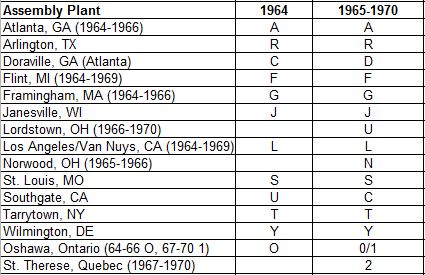 |
The last six digits of the VIN# are the sequential serial number. All assembly plants started at 100001 except in 1969. Number 2 would be 100002, etc. To find out your sequence number, you can subtract 100,000 from it. In 1969, all assembly plants except for Janesville and Lordstown start the sequence at 000001.
Sample 1964 VIN number decode – 41169S207810
(4) 1964
(1169) Biscayne 4-door sedan – 6 cyl. engine
(S) St Louis, MO assembly plant
(207810) 107,810th fullsize Chevrolet built at St. Louis, MO
Sample 1965-1970 VIN number decode – 164878J206840
(16487) Impala 2-door sport coupe – 8 cyl. engine
(8) 1968
(J) Janesville, WI assembly plant
(206840) 106,840th fullsize Chevrolet built at Janesville, WI
1964-1966 Canadian VIN Format
Before 1967, the Canadian VIN format was different than what was used in the U.S. It started with the year followed by the body number and the sequential serial number. No plant code was used. The last six started at 000001.
Sample 1964-1966 Canadian VIN number decode – 516469012345
(5) 1965 (16469) Impala 4-door sedan
(012345) 12,345th fullsize Chevrolet built at Oshawa, Ontario
Partial VIN Definition and Location
In addition to the VIN plate, the partial VIN of the car was sometimes stamped on the body in up to two places. Starting in 1967, the partial VIN was stamped on the top of the cowl (under the cowl vent panel) or on the firewall around the opening that would be covered by the heater or air conditioning box.
Cowl Tag Decode
The cowl tag is an aluminum tag attached to the firewall of the body. It contains interesting information pertaining to the body of the car such as what week it was built, the paint and interior colors and the options that would have required modifications to the body shell. In 1964, the cowl tag can be found on top of the firewall on the passenger’s side. Starting in 1965, it was moved to the front of the firewall on the driver’s side by the brake booster. The general format of the cowl tag remained the same from 1964-1970 and will be explained below. One exception is the cowl tags of cars built at Oshawa, Ontario (until 1967) and those assembled overseas. Those tags will be covered in a future update.
The body build date tells the month and week the body was produced. The date code starts with a number for the month, followed by a letter for the week. For the month: 01 = January, 05 = May, 09 = September and 12 = December, etc. For the week: A = 1st week of the month, B = 2nd, C = 3rd, D=4th and E=5th. In a few cases, the build date might vary such as the week being identified with a number. In 69, the location changed from the top line to under the interior code.
The top line can contain more information depending on the assembly plant. Some plants put a sequence number next to the date code or above the body number. The sequence number was used in the body plant for scheduling the shells to come down the line in order. A single letter can sometimes be found in this location as well, which usually identifies the interior paint code. That code can also be found on the protectoplate. During 1964 and 1965, the Euclid, OH plant, which produced convertible and wagon bodies for final assembly at Flint, MI stamped an F in that location. It is to denote the Flint plant and is not for the interior color.
2nd Line
The 2nd line (1st in 69/70) contains the year, body style number and assembly plant info. The year precedes the body style such as 64, 67, 70, etc. For information on decoding the body style, see the chart in the VIN number section. The body style on the cowl tag is typically in a V8 format, even if the car came with an L6 engine. Some plants however, did stamp a L6 body style on the cowl tag if it was to be assembled with that engine. In most cases, the assembly plant code is followed by either the sequential body number or the order confirmation number found on factory paperwork like the window sticker.
Plant Code Chart
Notes:
- Oshawa starting using OS in 1967. In previous years there was no plant designation on the cowl tag.
- Euclid produced convertible and station wagon bodies for the Flint plant in 1964 and 1965.
- The plant code for Los Angeles/Van Nuys changed mid-year in 1969 from LOS to VN.
Paint
The paint code can consist of letters, numbers or both. It varied by year. It was a three digit number up to 1965 when it became a letter. It returned to a number in 1969. The numerical code is listed in parenthesis next to the paint name. Note: Wilmington put the color of the wheels as a third letter (or 2nd on convertibles) in the paint code for 1965.
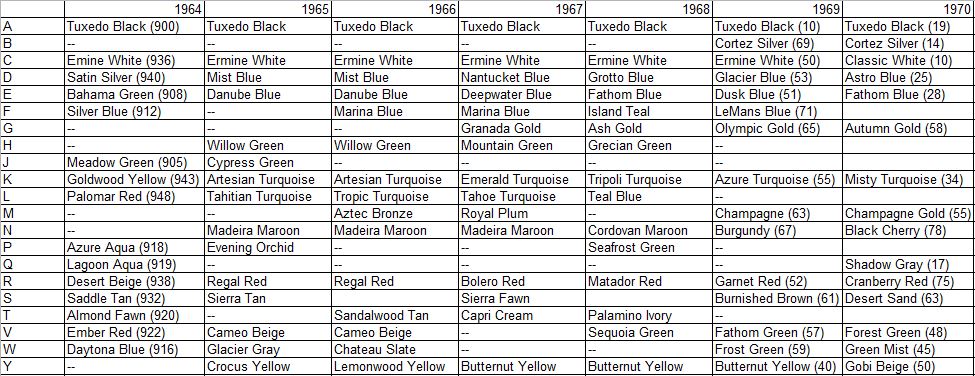
Two-tone Paint Codes
The typical two-tone paint code was a combination of two of the available paint codes as suggested by Chevrolet. In 1964, the paint code was a single three digit number between 952 and 995.
952 – Meadow Green/ Bahama Green
954 – Meadow Green/ Ermine White
959 – Silver Blue/ Ermine White
960 – Silver Blue/ Daytona Blue
965 – Lagoon Aqua/ Ermine White
971 – Desert Beige/ Saddle Tan
975 – Ember Red/ Desert Beige
982 – Satin Silver/ Daytona Blue
988 – Ermine White/ Azure Aqua
993 – Palomar Red/ Desert Beige
995 – Palomar Red/ Satin Silver
Convertible and Vinyl Tops
The convertible and vinyl top codes appear after the paint code and sometimes after the interior code. A number was used up to 69 when they changed to a letter.
In 67, the tan vinyl top color became light fawn instead of beige.
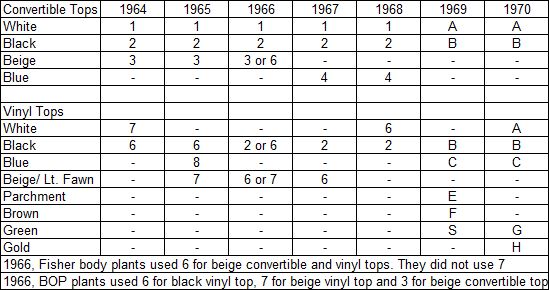
Interior
The interior code is a three digit number that shows the color, fabric type and style of the seats. A single letter or number can follow it. The Wilmington, DE assembly plant listed the interior paint code after it 1964-1968. Some plants listed the top (vinyl or convertible) color in this location with a number and some other assembly plants used a letter in 1966 and 1967 to signify the front seat type and whether it had headrests.
See the below interior charts for your year.
| 1964 | Fawn | Aqua | Red | Green | Blue | Black | Saddle | Silver | White/Aqua | White/Red |
|---|---|---|---|---|---|---|---|---|---|---|
| Biscayne [wagon] | 860 [861] | 852 [855] | 876 [877] | x | x | x | x | x | x | x |
| Belair | 863 | 850 | 872 | 823 | 839 | x | x | x | x | x |
| Impala cloth | 866 | 853 | 874 | 826 | 842 | 811 | 857 | x | x | x |
| Impala vinyl | 870 | 847 | 886 | 829 | 836 | 814 | 859 | x | x | x |
| Impala Super Sport - bucket seats | 856 | x | 879 | n/a | 831 | 815 | 862 | 805 | 845 | 878 |
Note for 1964: Biscayne sedan interiors were cloth except for the 865 fawn fleet-type vinyl. Wagons got vinyl interiors.
| 1965 | Fawn | Aqua | Red | Green | Blue | Black | Saddle | White/Aqua | White/Black | Slate |
|---|---|---|---|---|---|---|---|---|---|---|
| Biscayne [wagon] | 860 [861] | 852 [855] | 876 [877] | x | x | x | x | x | x | x |
| Belair | 863 | 850 | 872 | 823 | 839 | x | x | x | x | x |
| Impala cloth | 866 | 853 | 874 | 826 | 842 | 811 | 857 | x | x | x |
| Impala vinyl | 870 | 847 | 886 | 829 | 836 | 814 | 859 | x | x | x |
| Impala Super Sport - bucket seats | 856 | 845 | 879 | x | 831 | 815 | 862 | 845 | 802 | 805 |
| Caprice | 858 | x | x | x | 843 | 817 | x | x | x | x |
Note for 1965: Biscayne sedan interiors were cloth except for the 865 fawn fleet-type vinyl. Wagons got vinyl interiors.
| 1966 | Fawn | Turquoise | Red | Green | Blue | Black | Ivory | Bright Blue | Bronze |
|---|---|---|---|---|---|---|---|---|---|
| Biscayne [wagon] | 860 [861] | x | 876 [877] | x | 840 [832] | x | x | x | x |
| Belair [wagon] | 863 [867] | 850 [854] | 872 [878] | x | 839 [833] | x | x | x | x |
| Impala cloth | 866 | 853 | 874 | 826 | 842 | 811 | x | x | x |
| Impala (all) & Caprice wagon (vinyl) | 870/859 | 847 | 871 | 829 | 836 | 814 | x | x | x |
| Impala Super Sport - bucket seats | 869/862 | 846 | 873 | 830 | 837 | 813 | 885 | 844 | x |
| Caprice (strato-bench in parenthesis) | 857 (868) | x | x | x | 843 (834) | 817 (818) | x | x | x |
| Caprice - bucket seats | 856 | 848 | 879 | x | 831 | 815 | x | x | 891 |
Note for 1966: Biscayne and Belair sedan interiors were cloth except for the 865 fawn fleet-type vinyl. Wagons got vinyl interiors. The 869 SS interior became 862 in January of 1966.
| 1967 | Fawn | Turquoise | Red | Gold | Blue | Black | Parchment | Bright Blue | Plum |
|---|---|---|---|---|---|---|---|---|---|
| Biscayne [wagon] | 801 [802] | x | x | x | 840 [832] | 812 [812] | x | x | x |
| Belair [wagon] | 803 [804] | 850 [854] | x | x | 839 [833] | 819 [820] | x | x | x |
| Impala cloth | x | 853 | 874 (Maroon) | 888 | 842 | 811 | x | x | x |
| Impala (all) & Caprice wagon (vinyl) | x | 847 | 871 | 889 | 836 | 814 | 894 | 845 | x |
| Impala Super Sport - bucket seats (strato-bench in parenthesis) | x | x | 873 (870) | 890 (885) | x | 813 (810) | 895 (898) | 844 (848) | x |
| Caprice | x | x | x | 887 | 843 | 817 | x | x | 860 |
| Caprice strato-bench [vinyl in brackets] | x | x | x | 886 [884] | 834 [835] | 818 [821] | x | x | 862 |
| Caprice - bucket seats | x | x | x | 891 | 837 | 815 | x | x | x |
Note for 1967: Biscayne and belair sedan interiors were cloth except for the 865 fawn fleet-type vinyl. Wagons got vinyl interiors. The 812 black vinyl interior was available in both sedans and wagons.
| 1968 | Saddle (wagon only) | Turquoise | Red | Gold | Blue | Black | Parchment | Teal | Gray/Green |
|---|---|---|---|---|---|---|---|---|---|
| Biscayne (vinyl) | 837 | x | x | 831 (865) | 816 [817-wagon] | 802 | x | x | x |
| Belair (vinyl) [wagon] | [838] | 843 [844] | x | 832 | 818 (819) | 803, 811 [804] | x | x | x |
| Impala cloth | x | 842 | x | 833 | 820 | 805 | x | x | 853 |
| Impala (all) & Caprice wagon (vinyl) | 839 | 845 [wagon] | 866 | 830 | 821 | 806 | 858 | 864 | x |
| Impala Super Sport bucket seats | x | x | 868 | 836 | x | 812 | 859 | 862 | x |
| Caprice [vinyl in brackets] | x | x | x | 834 | 822 [815] | 807 [814] | x | x | 852 |
| Caprice strato-bench | x | x | x | 835 | 823 | 808 | x | x | 856 |
| Caprice - bucket seats | x | x | x | 840 | 824 | 809 | x | x | 857 |
Note for 1968: The 802 black vinyl interior was available in both Biscayne sedans and wagons. Black and blue vinyl interiors were available in all Belairs but wagons had a different code (804) for black than sedans (811).
| 1969 | Saddle (wagon only) | Turquoise | Red | Gold | Med. Blue | Dark Blue | Black | Parchment | Med. Green | Dark Green |
|---|---|---|---|---|---|---|---|---|---|---|
| Biscayne/Brookwood | 831 | x | x | x | 816 [815 wagon] | x | 802 (810 Fleet) | x | 849 (Biscayne) | x |
| Belair/Townsman [vinyl in parenthesis] | 838 | x | x | x | 818 (819) | x | 803, (804) | x | 850 [851 wagon] | 848 |
| Impala cloth | x | 844 | x | 837 | x | 820 | 805 | x | 852 | 860 |
| Impala (all) & Kingswood wagon (vinyl) | (830) | x | 866 | x | x | 821 | 806 | 858 | 853 | 861 |
| Impala bucket seats | x | x | 867 | x | x | x | 812 | 859 | 854 | x |
| Caprice (knit in parenthesis) | x | 846 | x | 840 | 822 | (826) | 807 (813) | x | 856 | (855) |
| Caprice - bucket seats | x | x | x | x | x | 824 | 809 | x | 862 | 857 |
Note for 1969: The 808 black Caprice interior was the only strato-bench seat available for 1969
| 1970 | Saddle | Turquoise | Red | Gold | Med. Blue | Dark Blue | Black | Sandalwood | Dark Green |
|---|---|---|---|---|---|---|---|---|---|
| Biscayne and Brookwood | 831 | x | x | 843 (Biscayne) | 815 | x | 802 | x | x |
| Belair [Townsman] | [838] | x | x | x | 818 [819] | x | 803, 804 [804] | x | 848 |
| Impala cloth | x | 844 | x | 837 | 820 | x | 805 | x | 860 |
| Impala (all) & Kingswood wagon (vinyl) | 830 | x | 866 | 841 | 821 | x | 806 | 828 | 861 |
| Caprice | x | 845 | x | 840 | 822 | 826 | 813 | 870 | 855 |
On some assembly plants (except Wilmington, DE) in 1966 and 1967, a letter was used after the interior code to indicate the front seat type.
- A – Bench seat
- B – Bucket seats
- D – Strato-bench seat
- E – Bench seat with headrests
- L – Strato-bench seat with headrests
- S – Bucket seats with headrests
Below is a table of Fisher Body codes for the 1964-1967 Fullsize Chevrolets. There is no known factory documentation that lists every code so most of these were confirmed by comparing original cars to the codes on the tag. If you have seen any not on this list or can help confirm any, please contact us.
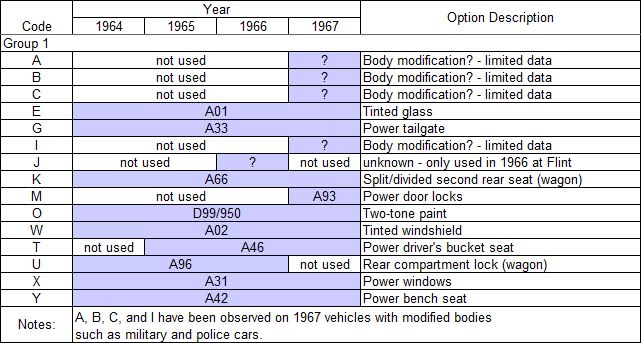
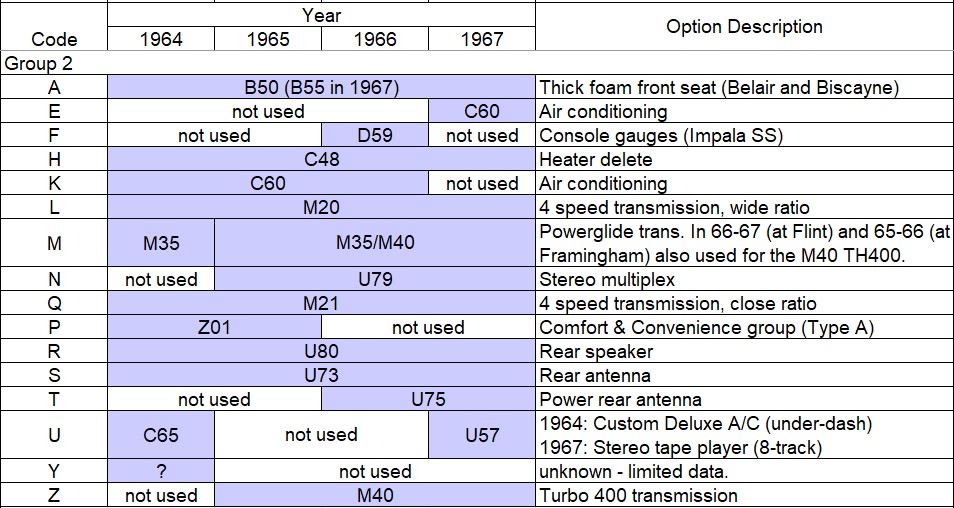

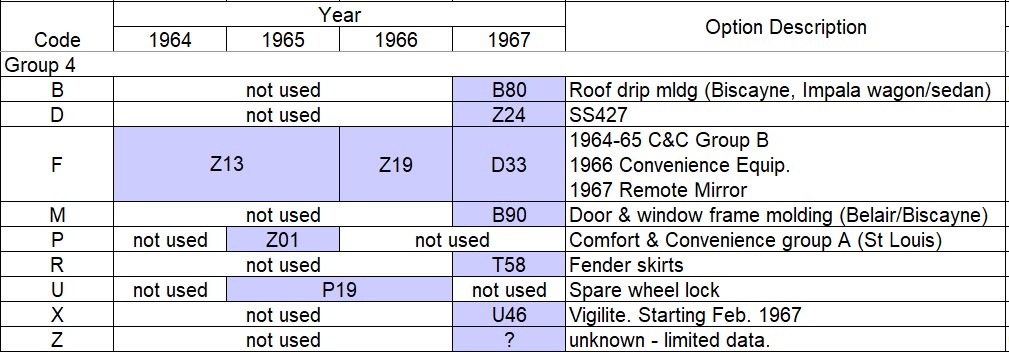
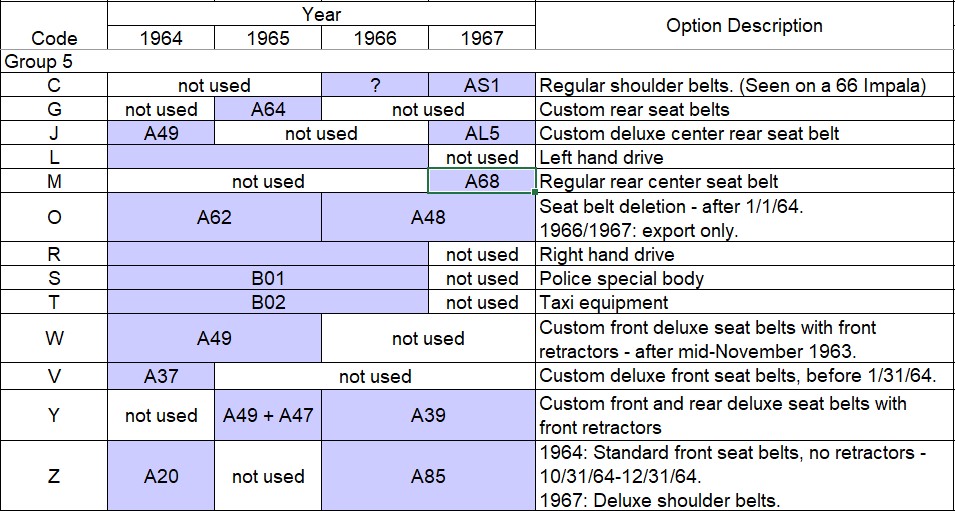 If you have any data to contribute to the research of these accessory codes, we would love to see it! In addition to these codes, some plants used the full RPO code on the cowl tag. You can find most of these in the above charts but there are a few you won’t see there.
If you have any data to contribute to the research of these accessory codes, we would love to see it! In addition to these codes, some plants used the full RPO code on the cowl tag. You can find most of these in the above charts but there are a few you won’t see there.
M11 – 3spd manual transmission on the column (if optional transmission not ordered)
B80 – Roof drip molding
B90 – Door window frame moldings
C08 – Vinyl top



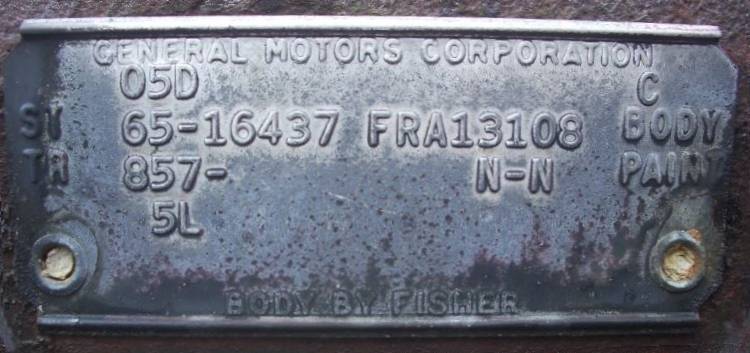
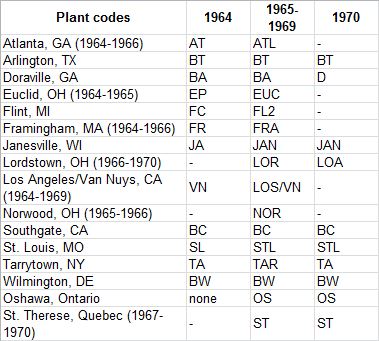
185 comments for “Vehicle Identification Number (VIN) and Cowl Tag Decoding”